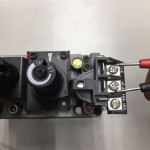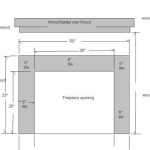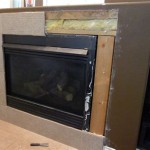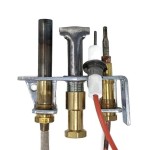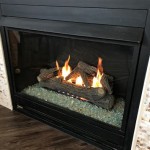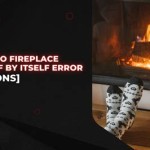How To Replace a Fireplace Damper Plate
A fireplace damper plate is a critical component that regulates airflow within the chimney, preventing both heat loss from the home and entry of unwanted elements such as rain, snow, and animals. Over time, damper plates can corrode, warp, or break down due to constant exposure to heat, creosote buildup, and the elements. A malfunctioning or damaged damper plate reduces fireplace efficiency, potentially leading to higher energy bills and posing safety hazards. Replacing a damaged damper plate is a necessary maintenance task to ensure the safe and efficient operation of a fireplace. This article provides a comprehensive guide to understanding the process of replacing a fireplace damper plate.
Identifying the Need for Damper Plate Replacement
Before undertaking any replacement project, it is crucial to accurately assess the condition of the existing damper plate and determine if replacement is indeed necessary. Several indicators point towards a failing or broken damper plate. One of the most common signs is visible rust or corrosion. Over time, the metal of the damper plate degrades due to exposure to moisture and acidic compounds in smoke. This corrosion can weaken the plate, making it difficult to open and close, or even causing it to crumble. Another sign is a warped damper plate. The intense heat of a fireplace can gradually warp the metal, preventing it from sealing properly. If a noticeable gap exists around the damper plate when it is closed, it signifies warping and necessitates replacement.
Difficulty in opening or closing the damper is another key indicator. A stuck or difficult-to-move damper suggests that the mechanism is either corroded, blocked by debris, or physically damaged. Attempting to force a stuck damper can potentially cause further damage to the mechanism. Visible cracks or breaks in the damper plate are an obvious sign of failure. These structural weaknesses compromise the damper's ability to effectively seal the chimney. Finally, a whistling sound emanating from the fireplace when the damper is closed suggests air leakage. This leakage often results from a warped or damaged damper plate, allowing cold air to enter the home, especially during windy conditions.
Gathering Necessary Tools and Materials
Replacing a fireplace damper plate requires a specific set of tools and materials to ensure a safe and effective installation. The first and most crucial tool is a replacement damper plate. Before purchasing a replacement, the dimensions of the existing damper plate must be accurately measured. This ensures that the new plate fits correctly within the firebox and seals the chimney opening effectively. Accurate measurements include the width and length of the plate as well as the diameter of the pivot point, if applicable. Consider purchasing a damper plate made from a durable material, such as stainless steel or heavy-duty cast iron, for longevity.
Safety equipment is paramount when working within a fireplace. Safety glasses protect eyes from debris and soot. Heavy-duty work gloves protect hands from sharp edges and potential contaminants. A respirator or dust mask is essential to prevent inhalation of soot, creosote, and other airborne particles. Other essential tools include a wire brush for cleaning the firebox and chimney opening, a scraper for removing stubborn creosote or debris, a penetrating oil or lubricant to loosen rusted bolts or hinges, and a socket set or wrench set to remove and install the damper plate. Depending on the type of damper and its installation method, screwdrivers (Phillips and flathead) may also be needed. A hammer might be required to tap the new damper plate into place, although excessive force should be avoided. Finally, a shop vacuum is useful for cleaning up debris and soot after the installation is complete.
Step-by-Step Guide to Damper Plate Replacement
Replacing a fireplace damper plate is a process that demands meticulous attention to detail and adherence to safety precautions. The first step involves preparing the work area. Spread drop cloths or plastic sheeting around the fireplace to protect flooring and furniture from soot and debris. Open windows in the room to provide ventilation, and ensure that the fireplace is completely cold before commencing work. Wearing safety glasses, gloves, and a respirator, thoroughly clean the firebox and chimney opening with a wire brush and scraper. Remove any loose soot, creosote, or debris that could impede the installation of the new damper plate.
Next, carefully examine the existing damper plate to determine its method of attachment. Some damper plates are held in place by bolts or screws, while others are secured with hinges or a pivot point. Apply penetrating oil or lubricant to any rusted bolts or hinges and allow it to soak for several minutes. Use a socket set, wrench set, or screwdrivers to remove the fasteners. If the damper plate is particularly stubborn, gently tap it with a hammer to loosen it from its position. Once the fasteners are removed, carefully detach the old damper plate from the firebox. Be mindful of its weight and condition as it could be fragile and covered in soot.
Before installing the new damper plate, compare it to the old one to ensure that it is the correct size and configuration. Verify that the mounting holes or pivot points align properly. Carefully position the new damper plate within the firebox, aligning it with the original mounting points. If the damper plate is secured with bolts or screws, insert the fasteners and tighten them until snug. If the damper plate is hinged, ensure that the hinges are properly aligned and lubricated. Test the operation of the damper by opening and closing it several times. Verify that it moves smoothly and seals tightly against the chimney opening. If any adjustments are needed, make them at this point. Once the new damper plate is installed and functioning correctly, use a shop vacuum to clean up any remaining debris or soot from the firebox and surrounding area.
Addressing Potential Challenges
While the damper plate replacement process is relatively straightforward, several challenges may arise during the project. One common issue is rusted or seized fasteners. Over time, bolts and screws can corrode and become difficult to remove. Applying penetrating oil and allowing it to soak for an extended period can often loosen these fasteners. If the fasteners remain stuck, consider using a bolt extractor or a specialized tool designed to remove damaged or corroded bolts. In some cases, it may be necessary to cut the fasteners with a hacksaw or angle grinder, but this should be done with caution to avoid damaging the surrounding firebox.
Another challenge is dealing with a damaged or deteriorated firebox. If the brickwork or metal components of the firebox are cracked, crumbling, or otherwise damaged, it may be necessary to repair or reinforce them before installing the new damper plate. Neglecting these repairs can compromise the stability and safety of the fireplace. Minor cracks can often be repaired with refractory cement or mortar, while more extensive damage may require professional masonry work. Inadequate chimney sweeping is another potential problem. A buildup of creosote and debris within the chimney can obstruct the damper's movement and reduce its effectiveness. Before installing the new damper plate, ensure that the chimney is thoroughly cleaned by a professional chimney sweep.
Finally, improper damper plate selection can lead to installation difficulties. Choosing a damper plate that is the wrong size or configuration will result in a poor fit and inadequate sealing. Always measure the existing damper plate accurately and compare the dimensions to the specifications of the replacement damper plate. If unsure about the specific type of damper plate required, consult with a fireplace professional for guidance. By anticipating and addressing these potential challenges, the damper replacement project can be completed safely and successfully.

How To Fix A Stuck Fireplace Damper The Blog At Fireplacemall

Fireplace Dampers Throat Vs Top Mount Swede Chimney Sweep Dryer Vent Cleaning

How To Make A Fireplace Damper Ehow

Chimney Damper Repair Fix A Broken
Replacing Damper Handle Lever Hearth Com Forums Home

What Is A Chimney Damper Why It Important
Fireplace Damper Replacement Long Island

Need To Get A Handle On Your Fireplace Damper Csia Can Help

What Is A Chimney Damper

Copperfield 3602910 27 Model Fans Blowers Venting
Related Posts

